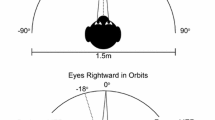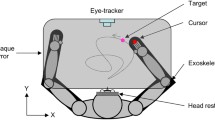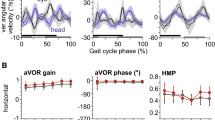Abstract.
Horizontal step-ramp target trajectories were used to study the initiation of head-unrestrained and head-restrained pursuit in the monkey. In a first series of experiments, initial target position (0°, 5°, or 30°, contraversive to the direction of pursuit), fixation duration, target velocity (20°, 40°, 60° and 80°/s), and target direction were randomized in order to minimize predictive responses. Animals pursued the target either with their eyes alone (head-restrained: HR condition) or with a combination of eye and head movements (head-unrestrained: HU condition). Head motion onset consistently lagged pursuit onset (i.e., eye motion) by 50 ms or more in the HU condition, and was influenced by target velocity as well as by initial target position. Pursuit onset latencies did not vary systematically as a function of target velocity in either the HR or HU conditions. However, pursuit initiation latencies tended to be longer in the HU condition as compared to the HR condition when target motion started from the most contraversive position. A second series of experiments revealed that this difference in HR and HU pursuit onset latencies could be explained by the effects of initial eye-in-head position; more contraversive initial eye positions yielded shorter pursuit latencies in both conditions, and the monkeys generally moved their head towards the target in the HU condition, resulting in smaller eye-in-head eccentricities. Furthermore, we found that initial gaze and head positions had little or no effect on pursuit latencies. We conclude that the latency for pursuit initiation is similar irrespective of whether an animal is head-restrained or head-unrestrained, when initial eye position is held constant.
Similar content being viewed by others
Author information
Authors and Affiliations
Additional information
Electronic Publication
Rights and permissions
About this article
Cite this article
Wellenius, G., Cullen, K. A comparison of head-unrestrained and head-restrained pursuit: influence of eye position and target velocity on latency. Exp Brain Res 133, 139–155 (2000). https://doi.org/10.1007/s002210000369
Received:
Accepted:
Issue Date:
DOI: https://doi.org/10.1007/s002210000369




